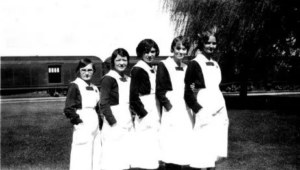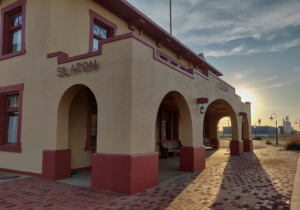 Past Matters, Spring 2025, Published 2/17/2025
Past Matters, Spring 2025, Published 2/17/2025
Slaton was a railroad town, quite literally. Named after a local rancher, the town itself was purpose-built in 1911 as an operational hub for what would become the largest division of the Santa Fe Railroad. On the heels of its dedication came Slaton’s Harvey House.
Most people hear Harvey House and think of Judy Garland, which is understandable given her turn as Susan in the 1946 MGM classic “The Harvey Girls.” And, although fiction, the story itself isn’t far off the mark with its tale of female empowerment in an era and locale often regarded as the domain of rugged cowboys and stoic ranchers.
Built and operated by entrepreneur Fred Harvey, Harvey Houses were America’s first chain restaurant. Working in partnership with the then Atchison, Topeka & Santa Fe Railway, Harvey would eventually open over 60 restaurants and dining cars in 12 states, becoming the sixth largest food retailer in the country. But Harvey Houses could not have attained their full glory without the dedication and effort of the Harvey Girls.
As the railroad pushed further west, the need for reliable staff became obvious. Male servers, it seemed, had a propensity for tardiness, drunkenness, and overall uncouth behavior while on the clock. In a time when only 15% of women were part of the paid labor force, Harvey used want ads in midwestern and eastern newspapers and magazines to recruit young, unmarried women of “good moral character.”
Applicants numbered in the thousands and selection was rigorous. The women were interviewed at length, went through 6 weeks of training, and were required to sign an affidavit attesting to their exemplary character. Those who made the cut were paid $17.50 a month at a time when urban waitresses made a third less. High wages, generous tips from appreciative travelers, safe room and board, and the prestige of becoming a Harvey Girl were all powerful motivators for applicants.
 Spreading westward along with each new Harvey House built, the women took with them the niceties of fine dining and genteel respectability. In doing so, women who had likely never been outside of their local communities often gained a financial and social autonomy that would have otherwise not been afforded to them.
Spreading westward along with each new Harvey House built, the women took with them the niceties of fine dining and genteel respectability. In doing so, women who had likely never been outside of their local communities often gained a financial and social autonomy that would have otherwise not been afforded to them.
In the decades that Harvey Houses were in operation, over 100,000 Harvey Girls helped change the course of women’s history in the American southwest. Many were the first women in their families to hold jobs or open bank accounts, others sent money back to their families, and some were able to become homeowners from their Harvey Girl savings.
In 1912 this legacy of elevated service and female independence debuted in Slaton, Texas. The Slaton Harvey House operated for 30 years as the town grew around it. Today it is one of six remaining Harvey Houses of the original eighteen built in Texas.
In January 2025, the Slaton Harvey House became the 40th state historic site of the Texas Historical Commission, embodying the memories of early 20th century life and women’s history for future generations of Texans to experience.